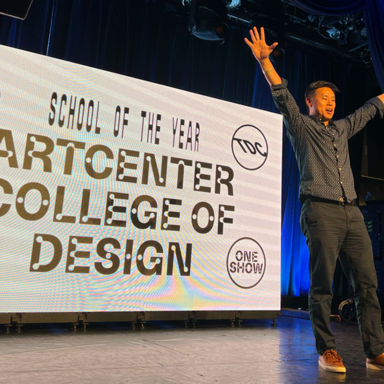
Desks from the Decades
By Alixandra Rutnik on Sep 22, 2023
Behind the scenes of The One Show’s 50th Anniversary with production company Eventique
We celebrated 50 years of The One Show at The One Club for Creativity this past spring, which means we have been awarding Gold, Silver, and Bronze Pencils to the best work in advertising for five decades, and counting. And if you were at the illustrious ceremony, you would have stepped into a time machine to see five desk set-ups, representing an ad agency in each of the five decades that The One Show has been around. It was certainly a nostalgia blast for the industry veterans at the show, and practically a museum for the juniors who weren't even born when the first Pencil was awarded.
We talked to Calleen Audrey, Event Designer, and Eric Wielander, Head of Strategy and Creative at production company Eventique to uncover the details on recreating the last 50 years of advertising.
How do you start an event project at Eventique?

Callen Audrey: We typically start with an RFP and then jump from their initial ask. Once we have feedback from that initial pitch, we dial in our questions to gain specific feedback and direction to move in.

Eric Wielander: I like learning as much about the client as possible. I find out what the client’s purpose is for holding the event, who will be in the room, have they done the event before, how we can do things differently - it’s an exercise we conduct to meet and exceed expectations.
What was the original brief from The One Show team?
Callen Audrey: The original ask was an interactive activation for the guests to experience 50 years of advertising and The One Show.
Eric Wielander: I’m doing this from memory. The key takeaway I recall from speaking with Gabriela Mirensky was that everyone in the room should feel like they’re a VIP. And, of course, the significant component of how we can visualize and communicate the past, present, and future of advertising in a milestone awards show.
Who came up with the idea for desks from the five decades to celebrate The One Show’s 50 years?
Callen Audrey: It started from a brainstorming session on how to show 50 years of advertising, and I had thought of doing a mini model of Time Square and displaying the varied advertisements in that space over each decade. Then I thought, well, if we are going to do a mini vignette, then we could show each decade in different ad settings, and then it snowballed from there.
"It started from a brainstorming session on how to show 50 years of advertising, and I had thought of doing a mini model of Time Square and displaying the varied advertisements in that space over each decade."
Has Eventique created scenes like this for an event before?
Callen Audrey: I think this is Eventique’s first time building mini-stage sets like this, but I have created little vignette scenes for other companies I worked for.
Eric Wielander: This reminds me of some scenes we created for one of the Humane Society’s galas. One year we celebrated the lives of three rescue dogs that were kinda famous on IG, and we took their stories and fabricated settings of how each dog was living their best life (e.g., a rescue dog in a pre-war library room on the Upper West Side) where guests could take their picture in the scenes — with the dogs.
"One year we celebrated the lives of three rescue dogs that were kinda famous on IG, and we took their stories and fabricated settings of how each dog was living their best life."
What research went into creating these desk sets from the 70s, 80s, 90s, 00s, and 10s?
Callen Audrey: What didn’t we research! We all collectively learned so much about software releases, computer evolutions, advertising companies, and their wins and failures. We even went down the rabbit hole of learning about the influence of music and art in the ad industry. It was a thrilling ride of nostalgia and “Whoa, I had no idea!”
What and who did you use to inspire you?
Callen Audrey: The jumping off point was creating the Ad Executive’s office in the 70s. The popularity of Mad Men had us focusing on that as a starting point, and then we moved into researching how the office space and dynamic changed over the decades, with people, hierarchies, technology, and workplace mindset.
"The popularity of Mad Men had us focusing on that as a starting point, and then we moved into researching how the office space and dynamic changed over the decades, with people, hierarchies, technology, and workplace mindset."
Once we had that locked in, everything started falling into place. The most challenging era was how do we show Y2K to the current because so many people remember that time vividly, and we knew it needed to feel as impactful as the earlier decades, which had more texture and nuances to them that made them more engaging.
Did you talk to people who worked in advertising during those times?
Callen Audrey: We talked with some people on the committee for The One Show, and I personally asked my mom and some of my uncles what the office was like in the 80s and 70s. They had color and texture opinions, but said that most everything was dated in the office because it took so long to review all the acquisition requests to get new equipment and furniture.
Did you pick a specific iconic person and imagine what their work life looked like?
Callen Audrey: That is a great idea, but we didn’t really have much to go off of for iconic people or places. I did specifically look up creative agencies in the early 2000s and what their new office spaces looked like. Still, other than that, we researched everything and anything to pull imagery and inspiration from.
Where did you source your materials for each set design?
Callen Audrey: It was a combination of fabrication, prop rentals, furniture rentals, Amazon, eBay, and Target. It was a very fun sourcing job because it was a “Where ever you can get it, then get it” no-restrictions sourcing excursion.
Did you do mocks up before transferring to the space?
Callen Audrey: Everything had to be approved, so we did a combination of 2D drawings and product listings for the detailed items. We had to fabricate the walls and their treatments, so we went through a couple of versions to ensure we had the background to set the environment.
What was the plan for setting things up in the event space?
Callen Audrey: We had a layout plan based on the larger items we sourced. A few decades shifted slightly once we saw everything in their space, but only by a little. We tried to plan everything out because we only had about six hours to build and wanted to ensure we were completely set before the doors opened.
What was challenging and fun about working on this project?
Callen Audrey: The biggest challenge was the scope of the five decades, and it felt like a lot in the planning process, so there were a few moments of, “Are we going to make it?” “Do we have enough stuff to fill the set?” but it all came together beautifully. Our team was two designers, one props master, four production assistants, and then the fabrication team to put up the walls was like three people.
Eric Wielander: And that’s just the team behind the 50 years of advertising. The production team consisted of about an additional eight people working around the clock.
What decade did you find the most inspirational?
Callen Audrey: Not sure about inspirational, but the 70s was the most photogenic, the 80s the most authentic, the 90s the most nostalgic, Y2K the most interactive and fun, and the current decade just had me shopping for my own at home office tchotchkes.
Eric Wielander: I grew up in the 80s so it’s a no brainer for me, but like many who also grew up in that era, I was absolutely taken aback by Apple’s 1984 commercial, it moved me to ask my boss at the time to try out his Macintosh, which I wound up buying from him and haven’t worked on another computer brand ever since.
From start to finish, describe the brainstorming process, from assembling one of the desk scenes to having to take it all down.
Callen Audrey: Oh, wow, that is a lot, our brainstorming process was hilarious and informative, and I enjoyed all the research and learning. Once we had the details down, everything just sort of fell into place. We had a team sourcing everything, so there was a ton of photo sharing through WhatsApp and Smugmug to ensure we were finding the right pieces, and then we just came together at 6 am the day of the event and worked like a well-oiled machine till it was all done. Taking it down was sad, but we did; it took about three and a half hours to break it all down.
After the event, what did you do with all of the desk items?
Callen Audrey: Some of the items were returned to prop houses, but a few select pieces made it into our office, like the dilbert coffee mug, the TRex staple puller, the pink and gold desk organizers, and all the pens/markers.
Eric Wielander: Well, some of us took our tchotchkes back!
Callen Audrey: Eric contributed the MacBook in the 90s activation, and it worked! He also had some easter egg items nestled in some decades.
Eric Wielander: I made memos from fake ad agencies. My favorite was the bike messenger memo with account codes for brands and campaigns at the time. We like to get super granular like that.
What is Eventique working on now?
Callen Audrey: We currently have some fun events in our creative pipeline. Watch our Instagram to see all our exciting events and experience our creativity.
Eric Wielander: The team who worked on The One Show just got back from Plano, Texas, where we produced a ribbon-cutting ceremony for a Korean company that’s manufacturing the fastest charging stations in the US right now.
Our summer will be spent preparing for the multitude of events we produce for the United Nations during the General Assembly in September.
Discover all the photos from The One Show's 50th Anniversary!
Related








